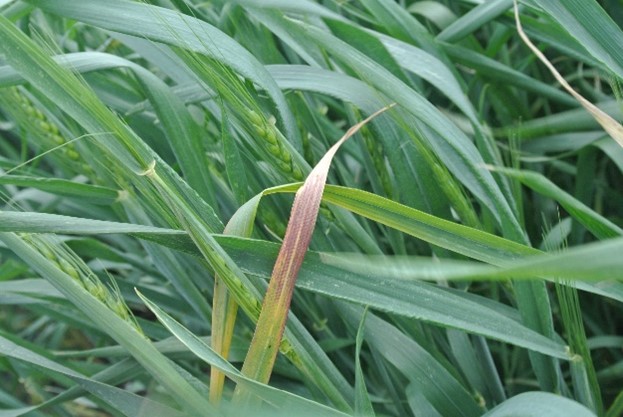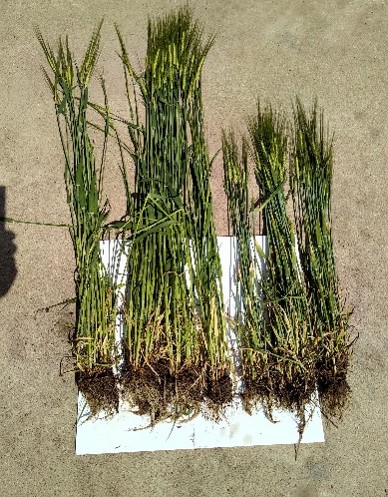Barley Yellow Dwarf Virus (BYVD) effects a wide range of grass hosts including wheat, oats and barley with oats being considered the most susceptible crop. In some regions of the province, BYDV has been reported as having a significant negative impact on oat yields.
Appearance:
The primary symptoms of BYDV include stunting and yellowing, reddening or purpling of the leaf tips (Figure 1 and 2). BYDV is often confused with nutrient deficiency or other environmental causes, or other virus diseases such as wheat spindle streak mosaic virus (WSSMV) or soil-borne wheat mosaic virus (SBWMV). Identifying viral pathogens is very difficult and requires a diagnostic test such as ELISA to confirm an infection. It is best to send samples to a diagnostic lab with these capabilities such as the Plant Disease Clinic, University of Guelph, Agriculture and Food Laboratory.


Disease Cycle:
BYDV is transmitted by aphids that have picked up the virus from other infected plants, and transmit the disease when feeding on host crops. These aphid species include the corn leaf aphid, the English grain aphid and the bird cherry-oat aphid. It only takes a few infected aphids within a population to infect several plants. Visible symptoms of BYDV do not usually appear until aphids are gone, but leads to underdeveloped root systems, decreased tillering, delayed maturity and symptoms of nutrient deficiencies. BYDV is usually found in patches 1–2 m (3–7 ft) in diameter but can occur uniformly throughout the field if aphid populations are also uniform throughout the field. Yield losses are very dependent on the crop stage when infected. The earlier the infection (prior to flag leaf), generally the greater the yield losses. In fall seeded cereals such as winter wheat and winter barley, fall infections can lead to yield losses of greater than 30%.
Management Strategies:
Once you have confirmed a BYDV infection in your field, there are little to no control options in season; however, there are management strategies that can be implemented to reduce the risk of infection:
Seeding date: Early planted winter wheat (before optimum planting dates) is at high risk for attracting infected adult aphids in the fall that are migrating from the southern US. In spring cereals, oats in particular, early seeding is an excellent defence against BYVD. Early seeding allows plants to reach more advanced stages of growth and development prior to aphid feeding, reducing yield losses. Insecticide sprays to control the aphids are not effective or economical, since scouting or detecting the aphids is very difficult. By the time populations reach detectable levels, virus transmission has most likely already occurred. Preventative sprays would not be economic as BYDV is unpredictable.
Note weather conditions and nearby crops: Aphids that carry the virus overwinter in winter wheat crops and can spread the virus to spring cereal crops such as oats. Several grass species, including corn and grassy weeds, are also reservoirs for BYDV and can create a green bridge between crops. Oat fields surrounded by winter wheat or other grass crops such as corn may be at greater risk for BYDV infection. BYDV infection is also favored by hot, dry conditions that favours aphid reproduction. Infected aphids can also be blown in from other regions or states that are already carrying the virus.
Variety selection and seed treatments: All cereal crops registered in Ontario are rated for barley yellow dwarf virus infection in the Ontario Cereal Crop Performance trial when the virus is present. If no virus is present, no rating is provided or there were no differences between varieties. To review a cereal variety’s BYDV rating (0-9 scale, with 9 being a high level of infection) please visit Go.Crops.ca. An insecticide seed treatment for aphid management can also reduce the amount of feeding that occurs but will not totally eliminate infection.
References:
AGRONOMY GUIDE FOR FIELD CROPS Publication 811 (ontario.ca)
Ontario Crop IPM – Wheat (gov.on.ca) – Cereal Aphid Identification
